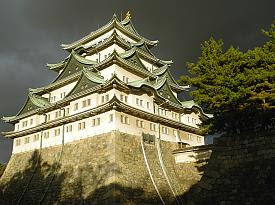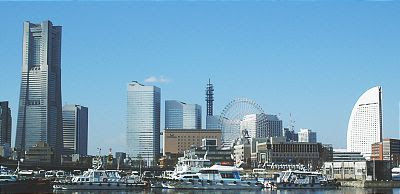Kyoto

Kyoto was Japan's capital and the emperor's residence from 794 until 1868. It is now the country's seventh largest city with a population of 1.4 million people and a modern face.
Over the centuries, Kyoto was destroyed by many wars and fires, but due to its historic value, the city was dropped from the list of target cities for the atomic bomb and spared from air raids during World War II. Countless temples, shrines and other historically priceless structures survive in the city today.
Tokyo
 Tokyo is Japan's capital and the country's largest city.
Tokyo is Japan's capital and the country's largest city.Tokyo is also one of Japan's 47 prefectures, but is called a metropolis (to) rather than a prefecture (ken). The metropolis of Tokyo consists of 23 city wards (ku), 26 cities, 5 towns and 8 villages, including the Izu and Ogasawara Islands, several small Pacific Islands in the south of Japan's main island Honshu.
The 23 city wards (ku) are the center of Tokyo and make up about one third of the metropolis' area, while housing roughly eight of Tokyo's approximately twelve million residents.
Prior to 1868, Tokyo was known as Edo. A small castle town in the 16th century, Edo became Japan's political center in 1603 when Tokugawa Ieyasu established his feudal government there. A few decades later, Edo had grown into one of the world's most populous cities.
With the Meiji Restoration of 1868, the emperor and capital were moved from Kyoto to Edo, which was renamed Tokyo ("Eastern Capital"). Large parts of Tokyo were destroyed in the Great Kanto Earthquake of 1923 and in the air raids of 1945.
Nagoya

With over two million inhabitants, Nagoya is Japan's fourth most populated city. It is the capital of Aichi Prefecture and the principal city of the Nobi plain, one of Honshu's three large plains and industrial centers.
Nagoya developed as the castle town of the Owari, one of the three branches of the ruling Tokugawa family during the Edo Period. Much of the city, including most of its historic buildings, were destroyed in the air raids of 1945.
Osaka

With a population of 2.5 million, Osaka is Japan's third largest and second most important city. It has been the economic powerhouse of the Kansai region for many centuries.
Osaka was formerly known as Naniwa. Before the Nara Period, when the capital used to be moved with the reign of each new emperor, Naniwa was once Japan's capital city, the first one ever known.
In the 16th century, Toyotomi Hideyoshi chose Osaka as the location for his castle, and the city may have become Japan's capital if Tokugawa Ieyasu had not terminated the Toyotomi lineage after Hideyoshi's death and moved his government to distant Edo (Tokyo).
Yokohama
 With a population of over three million people, Yokohama is Japan's second largest city. It is located less than 30 minutes south of Tokyo by train, and is the capital city of Kanagawa Prefecture.
With a population of over three million people, Yokohama is Japan's second largest city. It is located less than 30 minutes south of Tokyo by train, and is the capital city of Kanagawa Prefecture.Towards the end of the Edo Period (1603-1867), during which Japan isolated herself from the rest of the world, Western nations forced the country to open its ports to foreign trade. In 1859, Yokohama's port became one of the first ports to be openend, and Yokohama quickly grew from a small fishing village into one of Japan's major cities.
Until today, the Yamate residential area retains a Western touch and houses many foreign residents, while Yokohama's Chinatown is one of the world's largest. source:japan-guide.com
No comments:
Post a Comment